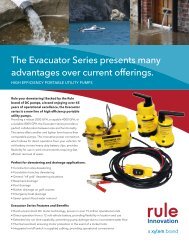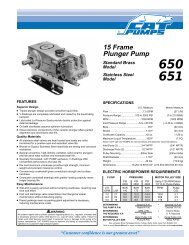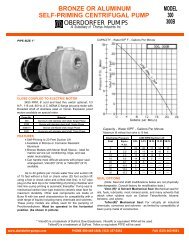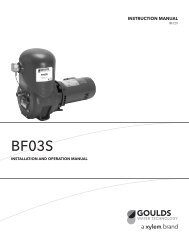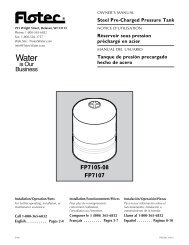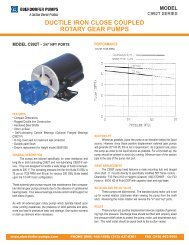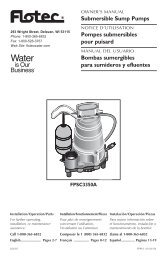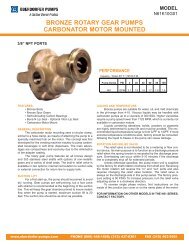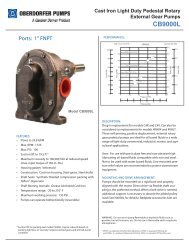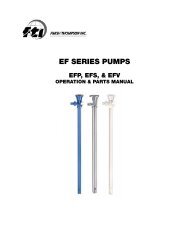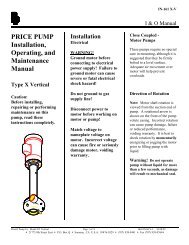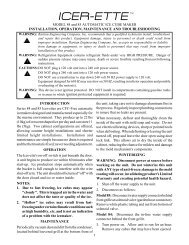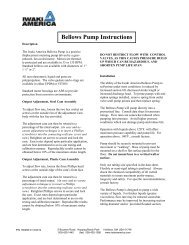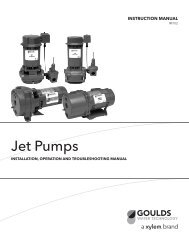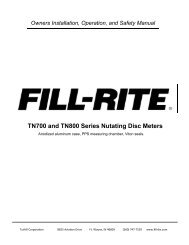Jet Pumps Pompes accélératrices Bombas de chorro - Flotec
Jet Pumps Pompes accélératrices Bombas de chorro - Flotec
Jet Pumps Pompes accélératrices Bombas de chorro - Flotec
You also want an ePaper? Increase the reach of your titles
YUMPU automatically turns print PDFs into web optimized ePapers that Google loves.
Troubleshooting 11<br />
Symptom Possible Cause(s) Corrective Action<br />
Motor will not run Disconnect switch is off Be sure switch is on.<br />
Fuse is blown or circuit breaker tripped Replace fuse or reset circuit breaker.<br />
Starting switch is <strong>de</strong>fective<br />
DISCONNECT POWER; Replace starting switch.<br />
Wires at motor are loose, disconnected, or<br />
wired incorrectly<br />
Refer to instructions on wiring (Page 9). DISCONNECT POWER; check and<br />
tighten all wiring.<br />
Capacitor voltage may be hazardous. To discharge capacitor,<br />
hold insulated handle screwdriver BY THE HANDLE and short capacitor<br />
terminals together. Do not touch metal screwdriver bla<strong>de</strong> or capacitor terminals.<br />
If in doubt, consult a qualified electrician.<br />
Pressure switch contacts are dirty<br />
DISCONNECT POWER and file contacts with emery board or nail file.<br />
Motor runs hot and overload Motor is wired incorrectly<br />
Refer to instructions on wiring.<br />
kicks off<br />
Voltage is too low<br />
Check with power company. Install heavier wiring if wire size is too small (See<br />
Electrical / Wiring Chart).<br />
Pump cycles too frequently<br />
See section below on too frequent cycling.<br />
Motor runs but no water is<br />
<strong>de</strong>livered*<br />
* Stop pump; then check<br />
Pump in new installation did not pick up<br />
prime through:<br />
1. Improper priming<br />
2. Air leaks<br />
3. Leaking foot valve or check valve<br />
In new installation:<br />
1. Re-prime according to instructions.<br />
2. Check all connections on suction line, AVC, and ejector with soapy water or<br />
shaving cream.<br />
3. Replace foot valve or check valve.<br />
prime before looking for<br />
Pump has lost prime through:<br />
In installation already in use:<br />
other causes. Unscrew<br />
priming plug and see if<br />
1. Air leaks<br />
1. Check all connections on suction line and shaft seal.<br />
water is in priming hole. 2. Water level below suction pipe inlet 2. Lower suction line into water and re-prime. If receding water level in well<br />
exceeds 25’ (7.6M), a <strong>de</strong>ep well pump is nee<strong>de</strong>d.<br />
Foot valve or strainer is plugged<br />
Clean foot valve or strainer.<br />
Ejector or impeller is plugged<br />
Clean ejector or impeller.<br />
Check valve or foot valve is stuck shut Replace check valve or foot valve.<br />
Pipes are frozen<br />
Thaw pipes. Bury pipes below frost line. Heat pit or pump house.<br />
Foot valve and/or strainer are buried in<br />
sand or mud<br />
Raise foot valve and/or strainer above bottom of water source. Clean foot valve<br />
and strainer.<br />
Water level is too low for shallow well<br />
setup to <strong>de</strong>liver water<br />
A <strong>de</strong>ep well jet will be nee<strong>de</strong>d if your well is more than 25’ (7.6M) <strong>de</strong>pth to<br />
water.<br />
Pump does not <strong>de</strong>liver water Water level in well is lower than estimated A new nozzle and venturi combination may be nee<strong>de</strong>d.<br />
to full capacity (Also check<br />
Steel piping (if used) is corro<strong>de</strong>d or limed,<br />
point 3 immediately above)<br />
causing excess friction<br />
Replace with plastic pipe where possible, otherwise with new steel pipe.<br />
Piping is too small in size<br />
Use larger piping.<br />
Pump <strong>de</strong>livers water but does Pressure switch is out of adjustment or DISCONNECT POWER; adjust or replace pressure switch.<br />
not shut off or pump cycles<br />
too frequently<br />
contacts are wel<strong>de</strong>d together<br />
Faucets have been left open<br />
Close faucets.<br />
Venturi, nozzle or impeller is clogged Clean venturi, nozzle or impeller.<br />
Standard pressure tank is waterlogged and<br />
has no air cushion<br />
Drain tank to air volume control port. Check AVC for <strong>de</strong>fects. Check all<br />
connections for air leaks.<br />
Pipes leak<br />
Check connections.<br />
Foot valve leaks<br />
Replace foot valve.<br />
Pressure switch is out of adjustment Adjust or replace pressure switch.<br />
Air charge too low in pre-charged tank DISCONNECT POWER and open faucets until all pressure is relieved. Using<br />
tire pressure gauge, check air pressure in tank at valve stem located on the tank.<br />
If less than pressure switch cut-in setting (30-50 PSI), pump air into tank from<br />
outsi<strong>de</strong> source until air pressure is 2 PSI less than cut-in setting of switch. Check<br />
air valve for leaks (use soapy solution) and replace core if necessary.<br />
Air spurts from faucets Pump is picking up prime When pump has picked up prime, it should pump solid water with no air.<br />
Leak in suction si<strong>de</strong> of pump<br />
Suction pipe is sucking air. Check joints for leaks with soapy water.<br />
Well is gaseous<br />
Consult factory about installing a sleeve in the well.<br />
Intermittent over-pumping of well. (Water<br />
drawn down below foot valve.)<br />
Lower foot valve if possible, otherwise restrict pump discharge.<br />
For parts or assistance, call <strong>Flotec</strong> Customer Service at 1-800-365-6832



